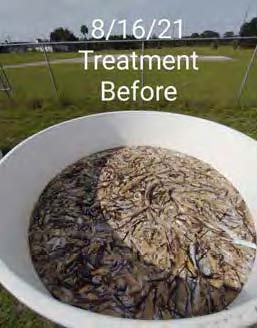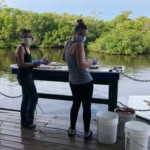Fish Kills: How to Turn a Negative into a Positive
by Dr. Michael L. Parsons, The Water School, Florida Gulf Coast University
As we all know, red tide kills fish. As dead fish decay, they release nutrients, fueling more red tide and causing a positive feedback loop (i.e., a compounding problem). By removing dead fish, a significant nutrient source could be eliminated, which should result in an attenuation of red tide (i.e., less nutrients = less cells). If a red tide bloom is smaller, the environmental and economic impacts should also be lower. Therefore, removing dead fish can be a mitigation tool for red tide. Additionally, fish carcasses are currently brought to landfills where they are treated as waste. They could be useful as a fertilizer if composted properly. In fact, they could potentially be certified as “organic” (the fish are wild after all) and serve as a “nutrient neutral” fertilizer (i.e., the nutrients in the fish came from the Gulf, and would return to the Gulf if utilized as a land-based fertilizer product).
In a partnership with Mote Marine Laboratory, researchers at FGCU’s Water School recently completed a study to measure the amounts of nutrients released by decaying fish (it was a stinky study!) and conducted small-scale composting to determine if composting could destroy red tide toxins (it can) and if a nutrient-rich product was produced suitable for fertilizer use (it was). In conjunction with researchers in FGCU’s Lutgert College of Business, we also demonstrated that even moderate red tides (>100,000 cells L-1) can cause significant economic losses (over $3 million per month in Collier County alone), and that fish removal initiatives are an economically feasible option ($2,000 – $6,000 per ton of fish.

One of the composting treatment tanks filled with dead fish collected off
Clearwater Beach last summer
In short, the data looks promising – a proactive fish removal program may reduce red tides. Notice the operative words used here, however: should and may. There are still some unknowns out there. Our next steps will be to find answers for questions like “How many Karenia cells are supported by the nutrients released by a decaying one-pound mullet? How about 1,000 dead mullet?” or “How much will red tide be reduced by removing 1,000 dead mullet?”. As you can see, while we have made much progress on this front, there are still critical questions that require answers before we can operationalize a fish removal program to mitigate red tide (and create an organic fish fertilizer!).






Leave a Reply
Want to join the discussion?Feel free to contribute!